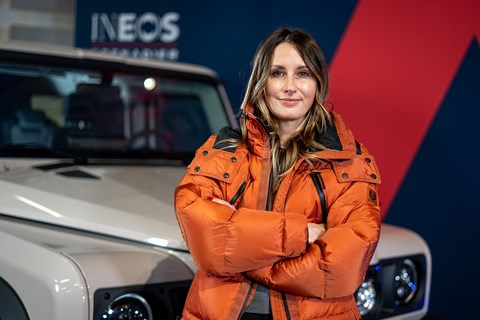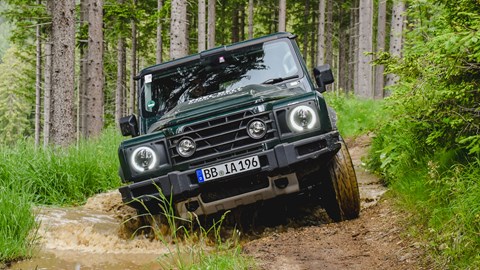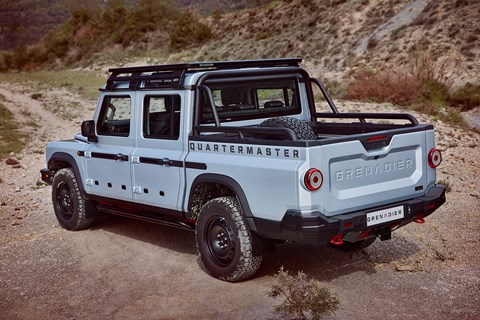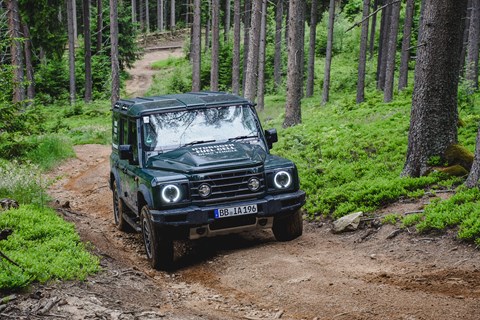► Interview with Ineos Automotive CEO Lynn Calder
► Boss talks of the transition to electric
► EV, hydrogen, ICE engines: a balancing act
Ineos CEO Lynn Calder has expressed her support for Rishi Sunak’s recent move to delay the ICE ban ‘til 2035 – but has warned that betting solely on EV may prove costly. Echoing comments made at this year’s Goodwood Festival of Speed, Calder outlined the pitfalls of pursuing electric cars as the only alternative to ICE.
Calder, in the job for just under a year now, is walking the same tightrope as every other industry boss: trying to decide which powertrain technology to back and at what velocity. It’s the most important strategic decision facing any chief exec – but it’s acutely pressing for Ineos, a small fledgling car manufacturer.
‘2035 is a more realistic target for consumers to switch to net zero vehicles and will allow the industry to meet the challenge,’ she said. ‘But achieving this target is made harder by the current singular focus on EVs as there is a real risk that that we will fail and that it will be more expensive for consumers, with the whole industry competing for finite resources such as the lithium crucial for batteries.’

Instead, Calder asked for similar levels of investment in other technologies such as a hydrogen: ‘We need support for other technologies such as hydrogen and alternative fuels in the same way these alternatives are being supported by other countries.’
‘I think all the automotive manufacturers are fully on board with decarbonising and finding the solution,’ Calder said. ‘We as an industry have some of the best brains on the planet. We are going to solve this. But a) we need time and b) we need to be open and innovating constantly, not saying “This is the one we pick and we go down that road”.’
To her the UK government’s insistence on an end to combustion-car sales in 2030 is not a coherent plan: ‘I’d like to see some policy. It’s a statement of intent with no means of getting there. What we’ve seen in the US more recently is intent plus some means of getting there, with the IRA [President Biden’s Inflation Reduction Act, involving $369 billion of funding for climate-related spending and clean-energy tax credits], saying we’re going to create some incentives and we’re going to incentivise technology, what’s going to actually solve this problem.’

Going electric, especially in a hurry, is inherently expensive. In the case of the Ineos electric 4×4 that Calder plans to have on sale in 2026, the powertrain costs roughly three times as much as a combustion equivalent. ‘It will only get worse as more and more countries pull from those limited raw materials.
‘What does failure mean? It means we don’t hit the targets on time. But failure also means we might hit the targets on time, but if everyone is fighting for the same raw materials in the world, it’s going to make it extremely expensive, and I fear that politicians are not quite understanding the gravity of what we have to achieve in such a short space of time. We might pretty much price consumers out of the car.’
Hydrogen should be part of the mix, says Ineos chief
Ineos Automotive has a fully functioning hydrogen fuel-cell version of the Grenadier, developed using some BMW technology and considerable know-how from elsewhere in the Ineos empire. ‘I think people would buy it but they need to be comforted that it’s a car they can use, and to use it they need to be able to refill it. That’s the frustration with policy at the moment – they’re picking horses and backing them, and I don’t think it’s wise.
‘We need a mix, we need different technologies that are going to get us there, otherwise we’re going to back a horse and we’re going to fail. EV, electrification, is a huge part of the solution, and we’re so into it, we’re building one. We really do think it’s a part of the solution, but the government’s saying it’s 100% of the solution.’
How hydrogen fuel-cell cars work
Phase 2 has begun
Calder is adamant that Ineos Automotive is here for the long term. ‘Our vision is that we want to be a long-term automotive player. We’re not here for five minutes, to show we can do it [build a successor to the classic Land Rover Defender, in the shape of the Grenadier and now the Quartermaster pick-up, below].

‘We’ve spent a lot of time in our own echo chamber with the Grenadier,’ she added. ‘When all you’re doing is listening to your own opinions, then everyone can be in great alignment and it’s all fantastic. But now we’re going to hear what everyone thinks. We’ve always said the public, the consumer, will be the judge of this vehicle. We will hear all sorts of things we don’t like. I want to listen to that, it’s really important.
‘I recognise really keenly the challenges we face as a new player. Such a big transition. Pretty much unprecedented. We feel like it’s been over 100 years since the industry has faced quite this much change. To be successful at that, and to be here in decades’ time, we need a portfolio of products, and the technology that’s needed for them. There’s going to have to be different powertrains to satisfy all the different markets. Electric isn’t going to work everywhere, hydrogen isn’t going to work everywhere, combustion isn’t going to work everywhere. How do you balance that portfolio in all of the 40-plus markets we’re going to be in, so that we’ve got that portfolio that people are going to say, “Yes, that’s the one I want”?
‘The battery-electric that’s coming in 2026 won’t be a Grenadier. It will still have that off-road DNA of course, but it won’t be a Grenadier, so we really are moving towards a portfolio of products. Phase two is business mode, having a business that’s long-term viable and being a customer-centric organisation, not a product-centric organisation, and that’s taking a bit of time. The organisation is moving from phase one to phase two. We’ve got a lot of people who have only ever known start-up. And now we’re trying to get towards business-as-usual mode, trying to get to run a business with monthly accounts and KPIs and things that we have to achieve.’
Will Lynn Calder miss the excitement of that start-up phase?
‘There is part of me that wants to retain the good parts of that: the agilty, the small-company feel where everyone feels like they’re pulling together to achieve something big. In the early days of phase two, we’re certainly still that. That attitude of get things done – we still retain that. But start-up mode also means it’s a bit chaotic. We need a bit of structure in order to be able to get where we want to go, in order to satisfy the hundreds of thousands of customers that we’ll have by the end of this decade. We need to grow up.

‘This is – sorry to use a horrible car pun – where the rubber hits the road; we’re going to find out how good we are, or not.
‘I’ve got a lot of experts in this business who know this industry inside out and back to front and I’d be an idiot not to listen to those people. We’ve built a really solid team over the last eight months that I’ve been in the business, and really proud how we’ve come together, and merged the automotive and non-automotive backgrounds that we now have. We’re doing a really good job of listening to each other.
‘We have our days when we’re like, gosh, this is really hard – because it is, it’s really hard. But I certainly wouldn’t want to be doing any other job. We are so excited about what’s next. There is so much change going on at the moment. The rulebook is being rewritten, whether people like it or not. It’s a lot, but my god it’s exciting.’
Ineos’s next big challenge: America
Pre-orders for the Grenadier have been going well in the USA, says Calder, but Ineos is keen to not rush into that massive market without first applying the lessons from the roll-out of the Grenadier in the UK, Europe and Australia, which involved some supply glitches and frustrating delays for customers.
‘I’m not going to sit here and pretend it will be seamless,’ Calder admits. ‘It’s a new distribution channel that we’re opening up. We have learned so much since we started production in October 2022, we have learnt as an organisation an enormous amount, and a huge amount of that will be brought to bear for the US. I think it will be a very different experience from us launching in the rest of the world.
‘We’ve tested our systems in anger now. We’re really in a much better space. We’ll come across things we’ve not come across yet, and we’ll have our moments. But we have learned shedloads. It will be a completely different experience, for us as a business, and for the end consumer.’
Now read our Ineos Grenadier review